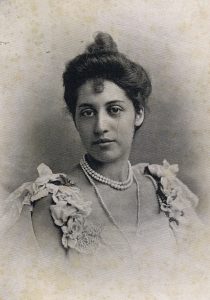Princess Sophia Duleep Singh
 Princess Sophia, the youngest of the Maharajah’s three daughters with Maharani Bamba, was born on the 8 August 1876. She was christened Sophia Jindan Alexdrowna Duleep Singh, named Sophia after Maharani Bamba’s mother and Jinda after Duleep Singh’s mother.
Princess Sophia, the youngest of the Maharajah’s three daughters with Maharani Bamba, was born on the 8 August 1876. She was christened Sophia Jindan Alexdrowna Duleep Singh, named Sophia after Maharani Bamba’s mother and Jinda after Duleep Singh’s mother.
It was during Princess Sophia’s illness in September 1887 that her mother, Maharani Bamba, passed away. The frail Maharani had spent all night praying beside her little girl and fell in to a coma herself and died the following morning. After the death of their mother, Princess Sophia was put under the care of Arthur Oliphant with her sisters and little brother Prince Albert Edward.
In 1906 Prince Frederick rented the lavish Blo Norton Hall, and around the same period he purchased the ‘Thatched Cottage’ in Blo Norton, for his sisters. The sisters conveniently named the cottage ‘Hampton House’ after Hampton Court Palace, which was located opposite the Princesses London home ‘Faraday House’. Hampton House was much like a mini-palace, having regal-like French doors, with steps leading up to the garden. As you went down the garden, the path had trellises of roses, going down like an avenue. Inside the house were beautiful Tudor beams, with a large warm fire, a ‘grand piano’ which the sisters joyfully spent many hours on,[i] elegant Mogul screens brought back from their visits from India and a mouth-piece telephone,[ii] only one of three in the village.[iii]
Princess Sophia joined the Suffragette movement and became a leading figure in the Women’s Social and Political Union (W.S.P.U.), fighting for the right for women to vote in Britain. On the 22 May 1911, Spelthorne Petty Sessions summoned Princess Sophia, for keeping a carriage, a manservant and five dogs without licences, and for using armorial bearings. Mr Leon Castello, who appeared for the Princess said she very much regretted that she could not attend the court herself. He admitted seven of the summonses, except that relating to the armorial bearing. The Princess had asked him to protest on her behalf against the injustice of making women, who had no voice in the management of the country, liable to taxation. The chairman said that they had nothing to do with that, and the bench decided to fine the Princess, £1 for not taking out dog licences, £1 for keeping a non-licensed male servant, and £1 for keeping an unlicensed carriage. The question of keeping an armorial bearing was reserved.[iv] She appeared in court again in December 1913, accompanied by fellow members of the league, for keeping two dogs and a carriage without licence. She made a stand stating that ‘taxation without representation’ was a tyranny. She added ‘I am unable conscientiously to pay money to the State, as I am not allowed to exercise any control over its expenditure, neither am I allowed any voice in the choosing of members of Parliament, whose salaries I have to help to pay. This is very unjust. When the women of England are enfranchised and the State acknowledges me as a citizen I shall, of course, pay my share willingly towards its upkeep. If I am not a fit person for the purposes of representation, why should I be a fit person for taxation?’[v]
During the First World War, Princess Sophia organised patriotic flag days for Punjabi troops of the Indian Army. She even went to lengths in visiting wounded Indian soldiers at Brighton Pavilion where they were being nursed. Many were honoured in meeting the granddaughter of the great Ranjit Singh, and requested mementos to take back home, for which she obliged, handing out signed photographs of herself. One such soldier of the ‘15th Sikhs’ was Kartar Singh, who wrote home to the Punjab from his sick bed at Milford-on-Sea in 1916, ‘My friend this is the photo of our king’s granddaughter – he who was King of the Sikhs, Ranjit Singh. She has distributed her photo amongst Sikh brethren at the depot [Milford] on the evening of the 23 February at five o’clock.’[vi]
Princess Sophia took part in the 10,000-strong ‘Women’s War Work’ procession led by Mrs Emmeline Pankhurst. She joined the ‘Suffragette Fellowship’ after the First World War, remaining its member to the end of her life. After Mrs Pankhurst’s death in 1928, Princess Sophia was appointed president of the committee.[vii]
On the 22 August 1948, Princess Sophia died in her sleep. Her solicitor Henry Charles Wanstall of Chancery Lane arranged for the cremation at Golders Green on the 26 August.[viii] It was her request that a full band shall play Wagner’s ‘Funeral March’ on her cremation, and that her ashes be taken to India for burial.[ix]
[i] The Piano remained in Hampton house for many years after, before it was shipped out in 1997 to the USA by the then owners
[ii] The directory listed the telephone under the name of Princess Sophia, number 2219.
[iii] Bruce Reeve, (1997)
[iv] ‘A Princess and her Taxes’: Votes For Women, 26 May 1911,
[v] Votes for Women, 2 January, p. 209.The Times, 30 December 1913
[vi] Letter dated 24 February 1916. Letter No 253, published in Omissi, Indian Voice of the Great War, p. 156
[vii] Calling All Women: Newsletter of the Suffragette Fellowship, February 1949, p. 7
[viii] Death registered at Wycombe. No. 485. Cremated at Golders Green Crematorium, Register No. 81394.
[ix] Last Will & Testament of P. Sophia Alexdrowna Duleep Singh, dated 29 June 1945